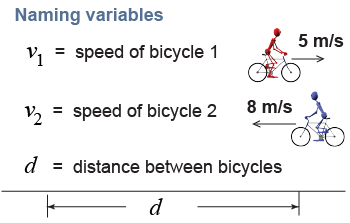|
Physics problems give you some information and ask you to apply physics to figure out something else. You need to analyze given information and think logically about how to get an answer. This section shows you how to analyze a problem that at first seems simple but is more complicated than it looks. 
|
How to start
|
 One of the most difficult steps in beginning a physics problem is how to start. That means translating diagrams and words into the language of math. Mathematics is indeed a language! To translate from English into math you need to know specific things.
One of the most difficult steps in beginning a physics problem is how to start. That means translating diagrams and words into the language of math. Mathematics is indeed a language! To translate from English into math you need to know specific things. - What is the problem asking for?
- What information are you given or do you know?
- What relationships involve what is asked and/or given?

|
The last sentence of the example problem tells you what the problem is asking for. “How long will it be before...” is a reference to time. This problem asks you to find a time. Choose the variable t to represent time. The letter t is a good choice. Mathematically, you are seeking a solution to the equation t = ? 
|
 You are given two speeds and a distance. Because there are two speeds, you cannot use just v for both. When there is more than one of the same type of variable a good strategy is to use subscripts. Make one bicycle “number 1” and the other “number 2.” The speed of bicycle number one is v1 (pronounced “vee one”). The speed of bicycle two is v2.
You are given two speeds and a distance. Because there are two speeds, you cannot use just v for both. When there is more than one of the same type of variable a good strategy is to use subscripts. Make one bicycle “number 1” and the other “number 2.” The speed of bicycle number one is v1 (pronounced “vee one”). The speed of bicycle two is v2. 
|
Write down all the relationships you know that involve the types of information you are asked and given. For this problem you are asked for a time. You are given speeds and a distance. The relationship you need is one that relates speed, distance, and time. This relationship is v = d/t. 
|

|

